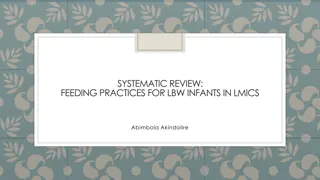Understanding and Promoting Human Flourishing in LMICs: Insights from TWCF Webinar Series
Explore the discussions on character virtue development, program design, and evaluation in low- and middle-income countries (LMICs) from the TWCF webinar series led by Richard M. Lerner, Marc H. Bornstein, and Elizabeth M. Dowling. Discover valuable insights on reliability, validity, and the use of tools to enhance positive youth development and flourishing. Delve into the nuances of conducting Randomized Control Trials (RCTs), measuring outcomes, and addressing missing data effectively.
Download Presentation

Please find below an Image/Link to download the presentation.
The content on the website is provided AS IS for your information and personal use only. It may not be sold, licensed, or shared on other websites without obtaining consent from the author. Download presentation by click this link. If you encounter any issues during the download, it is possible that the publisher has removed the file from their server.
E N D
Presentation Transcript
Building Programs, Evaluations, and Tools to Promote Human Flourishing in LMICs: Unasked Questions and Welcomed Answers TWCF Webinar 3: December 10, 2020 Richard M. Lerner, Marc H. Bornstein, and Elizabeth M. Dowling
The Goals of Character Virtue Development Programs in LMICs To enhance program participants character virtues and other indicators of positive development such as PYD, SEL, or thriving or flourishing. From preceding TWCF webinars, many ideas that can be useful for designing and evaluating effective programs have been presented. Useful tools exist for indexing specific instances of flourishing, character virtue development, and related constructs of relevance in specific communities in specific countries. 2
The Goal of This Webinar Prior webinars have provided useful answers to commonly asked questions about program design, evaluation, and the validity and reliability of measurement. However, some important issues still need to be discussed. Accordingly, in this final webinar we take the bold step of providing answers to some important but unaskedquestions. The questions and answers concern specific issues that revolve around validity and reliability in: Randomized Control Trials (RCTs) Measurement Missing data Using group averages to represent specific people in specific programs 3
How Deep Can We Go? Of course, in the time we have available for this webinar, we can only touch the surface of these questions and answers. Therefore, we invite you to work through the TWCF to ask for additional information, clarification, consultation, or support. Let s get started by first defining reliability and validity. We will then ask a question that Marc Bornstein answered in his webinar, but we think needs to be answered again about the validity of traditional approaches to conducting RCTs. 4
The Many Meanings of Reliability Reliability is consistency in observations. Reliability occurs when two observations yield the same result (e.g., a measure of the character virtue of gratitude yields the same scores on two different occasions). In experimentation, reliability means that the results of an experiment can be replicated. In survey research, reliability means that a correlations between two constructs (e.g., between purpose and generosity) is found in different samples. In measurement, reliability means that items (e.g., indexing humility) are interrelated ( internally consistent), that scores for the items are the same across different times of measurement, or that two independent raters provide the same scores. Also in measurement, reliability is the consistency in scores from two measures that are designed to be highly similar. 5
The Many Meanings of Validity Validity occurs when the observation represents what it is intended to represent. Validity exists when there is evidence that the construct (or latent variable ) that a researcher intends to measure is actually in evidence (e.g., there is evidence that a measure of the character virtue of gratitude actually measures gratitude). In experimentation, validity means that the outcome of the experiment is due to, and ONLY due to, the manipulation or treatment, and not to any other variable or event. This situation indicates internal validity. In survey research, validity means that a measure (e.g., of generosity) is correlated with or predicts something that occurs when the construct (generosity in this case) actually exists (e.g., the magnitude of anonymous annual charitable giving). In measurement, validity points to true indicators of the construct (or latent variable) a researcher is trying to measure. Also in measurement, validity exists when there is a strong relation between two measures of a construct that are designed to be maximally different. 6
Question 1 Are RCTs really the gold standard in program evaluation? If not, what alternatives are available? 7
Alternatives to the Traditional (2-group) RCT The Solomon 4-Group Design Econometric Alternatives to RCTs: Counterfactual comparative structural equation modeling using propensity score matching Regression discontinuity designs Instrumental variable analysis 8
The Solomon 4-Group Design Solomon, R.L., & Lessac, M.S. (1968). A control group design for experimental studies of developmental processes. Psychological Bulletin, 70, 1545 1550. 9
Randomized Control Trials (RCTs): The Gold Standard? As implemented through the first decades of the 21st century, many RCTs were Fools Gold. The entire purpose of an RCT is to assure internal validity. RCTs are internally valid if and only if pre-existing attributes of participants (termed selection effects or endogeneity ) are excluded as possible sources for variation in the outcomes of treatment or intervention. The traditional design of the RCT has only two groups a treatment (or intervention) group and a control group. However, not one, but three, control groups are needed to assure internal validity. 10
The Solomon and Lessac (1968) 4-Group Design: Overview of the Groups Needed for Internal Validity Experimental or Control Group Treatment Group 1 2 3 Pretest Treatment Posttest
Explaining the Logic of the 4-Group Design Intervention Groups Control Groups Condition 1 2 3 4 Pretest determines level of participants attributes before intervention Pretest Intervention Pretest-Posttest comparison determines effects of intervention improvement Posttest 12
Explaining the Logic of the 4-Group Design Intervention Groups Control Groups Now the Pre- and Posttests are substantively related to the intervention and so the Pretest gives relevant experience, and the Posttest=Pretest, so perhaps the Pretest is the active ingredient , not the intervention Condition 1 2 3 4 -- Pretest Intervention Group 1 v. 2 comparison shows/eliminates effects of Pretesting vs Intervention Posttest 13
Explaining the Logic of the 4-Group Design Intervention Groups Control Groups Group 3 with no intervention also tests the Pretest priming Condition 1 2 3 4 Pretest Comparing Groups 1 v. 3 on the Pretest-Posttest difference reveals the unique or non-effect of the intervention Intervention Posttest 14
Explaining the Logic of the 4-Group Design Intervention Groups Control Groups Between the Pretest and Posttest in Group 1, participants grow and change Groups 1 v. 4 compare intervention with development; Hawthorne Effect ; and diffusion or contamination Condition 1 2 3 4 Pretest Intervention Posttest 15
Explaining the Logic of the 4-Group Design Intervention Groups Control Groups Condition 1 2 3 4 Pretest Intervention Posttest 16
Options for Comparison or Control Groups (Bornstein, 2020) The No Treatment (or Business-as-Usual) condition: Participants are offered no participant-related support as part of their study participation. The Nominal Support condition: Participants are offered a modest level of assistance related to, but not part of, the actual support or intervention design. The Treatment (or Intervention) Component condition: Participants are offered an element or lower dosage of the intervention. The Attention Placebo condition: Participants are offered contact with the intervention staff at the same intensity as participants in the actual support and intervention minus the focus of the intervention. The Waitlist Comparison condition. Participants receive the treatment condition but wait (with no treatment) to receive it until the end of the assessment of the original treatment (intervention) group. A waitlist control group can be used to assess the replicability of the treatment. If so, then the initial treatment group and the waitlist control group need to be treated identically. 17
Econometric Alternatives to RCTs: 1. Counterfactual comparative structural equation modeling using propensity score matching There may be practical or ethical constraints in assigning people to participate in specific programs (e.g., involving character virtue education) and, of course, people cannot be randomly assigned to race, gender, poverty, or religious groups. However, people who are in a program also have specific race, gender, poverty, religious, etc. attributes. These attributes exist also among people who are not in the program. This second group of people are called counterfactuals. A propensity score is the probability of a person being assigned to a group based on all the variables that encompass a group, either the program group or the counterfactual group (these variables are termed covariates). Covariates can be used to create a counterfactual sample matched to the program sample through propensity score matching, thereby reducing selection bias (endogeneity). Statistical procedures (e.g., structural equation modeling, or SEM) can be used to model the causal effects of program participation (e.g., on character virtue development). 18
Econometric Alternatives to RCTs: 2. Regression Discontinuity Designs A pretest cutoff score is used to assign participants to either the program or comparison group. The assumption is that in the absence of the program the pre-post relation would be equivalent for the two groups (William Trochim, 2006). 19
Econometric Alternatives to RCTs: 3. Instrumental Variable (IV) Analysis An instrument is a variable that does not itself belong in the explanatory equation and is correlated with the endogenous explanatory variables, conditional on the other covariates. In attempting to estimate the causal effect of some variable x on another y, an instrument is a third variable z which affects y only through its effect on x. For example, to estimate the causal effect of ( x ) smoking on ( y ) general health, one may use the tax rate on tobacco products ( z ) as an instrument for smoking in a causal analysis: If tobacco taxes (z) affect health (y) only because they affect smoking (x) (holding other variables in the model fixed), the correlation between tobacco taxes and health is evidence that smoking causes changes in health. 20
Question 2 These alternatives show that you can create compelling evidence for the effectiveness of a program in several ways different from conventionally designed (2-group) RCTs. Designing evaluations is one thing. Using measures that reflect desired outcomes is quite another. Given my limited resources of staff, time, and money, must I develop measures that have meaning, validity, and reliability in my specific setting and with the specific individuals in my program? Why can t I just use measures that have been used before, especially if they have been shown to be reliable? 21
Reliability and Validity in Measurement Reliability and validity are attributes of specific participant s behaviors and not of the words on a survey (Noel Card, 2017). People are reliable or not reliable. People s actions are or are not valid indications of their true thinking, feeling, or behavior. THEREFORE, you must establish reliability and validity for the specific groups with whom you are working! A measurement tool may or may not provide an observation that is a true (valid) indication of an individual s functioning at one point in time or of the person s development. Measures must be change sensitive. Measures must also be relevant to specific developmental levels and to specific cultural contexts of participants. Most important, measures must be indictors of reliable AND valid attributes of an individual. Unfortunately, many researchers trade validity for higher reliability. 22
Trade-Offs Between Reliability and Validity (Card, 2017; Clifton, 2019) The purpose of measurement is to obtain a true index of a facet of an individual s behavior and/or development. However, all measurement involves variation from three sources: 1. True assessment of a specific observable behavior or of a latent construct, 2. random error, and 3. systematic error. Random error can occur when a person misreads a word, is distracted by a fly landing on his head, or there is an electrical outage when taking an online survey. Systematic error occurs when the method of administering a measure biases participants responses to the measure. Importantly, systematic error tends to increase reliability of responding but decreases validity of responding. 23
Sources of Systematic Error: Slide 1 Following Clifton (2019), some sources of systematic error and of the tradeoff between reliability and validity include: 1. Item language problems: Similar words or grammatical structures introduce systematic error associated with those words or structures. For example, if a 10-item scale has 5 items that begin with I feel that ... but the remaining 5 items have five quite different wording (e.g., I believe , I think, My view is , etc.). The I feel that ... items are likely to correlate highly with each other and increase reliability all driven by systematic error associated with language similarity and not measurement of the true construct; 2. Acquiescence bias: Acquiescence bias (agreement bias) is the tendency for respondents to agree with items regardless of what the item is about; 24
Sources of Systemic Error: Slide 2 3. Fixed-order bias: Administering items in a fixed order is problematic because each item serves as a prime for the next. Although sequence effects vary in magnitude, every item administered in a sequence inevitably influences those that follow in a nonrandom way. The result is increased communality among items, increased reliability, and weakened validity; and 4. Response bias: The results of demand characteristics as shown in consistent responding, deviant responding, careless responding, agreement bias, affect bias, and social desirability. 5. Item difficulty: Variance among items may be an artifact of specific levels of difficulty. For example, among items involving understanding moral reasoning principles and understanding mathematical concepts, there may be two groups of highly correlating items: hard items and easy items. Analyses may capture this variance in item difficulty and result in spurious dimensions, which are termed difficulty factors. 25
How Systematic Error Can Affect Reliability Through Use of Cronbach s Alpha Coefficient Coefficient alpha is a standard measure of the internal reliability of a scale (that is, the covariation among items in a scale). Imagine a 9-item scale involving 5 items concerning gender and 4 items concerning hair color. If interitem correlations averaged .95 within the 5- and 4-item sets and .00 between sets, the average correlation across all 9 items would be .42, alpha would be very good at .87, and yet the scale as a whole would measure nothing. Therefore, incremental change in alpha indicates that the proportion of covariance among items is increasing without providing insight into why. 26
Question 3 So now we understand more about how to reduce systematic error and obtain estimates of reliability that increase true variance about the construct (the latent variable) we want to measure. But, if validity is the goal that is, if we want a true measure of the construct in which we are interested what measure of validity should I use? 27
Validity Validity involves the correct identification of the latent variable (e.g., the character virtue of generosity, purpose, or humility), which is a conceptual (theory-based) determination of meaning. That is, validity is subjectively determined. No numerical indicators or rules of thumb are applicable to all instances of validity. Distinguishing high versus low validity is meaningless because validity is non-numerical (Anastasi & Urbina, 1997). In other words, validity is in the eye of the beholder, or in the theoretical explanation of why a specific form of validity is useful. 28
Types of Validity: Slide 1 of 2 Content validity: The degree to which items denote the right construct, the entire construct, and nothing else. Content validity is what should determine scale labels. Predictive validity (or criterion-related validity): The degree to which scale scores occupy the right spot in the nomological net or have the right (i.e., theoretically expected) empirical associations. Divergent and convergent validity: Scores are unrelated to (have no correlation with) variables presumed to be unrelated (divergent/discriminant validity) BUT are significantly correlated with variables presumed to be related (convergent validity). 29
Types of Validity: Slide 2 of 2 Incremental validity: The measure accounts for new variance in variables presumed to be related to the measure (e.g., a measure of forgiveness adds to the variance associated with other measures of character virtues). Concurrent validity: A measure is highly correlated with variables presumed to reflect the same latent phenomenon. Expert rater validity: Experts agree that a measure (or items) are indicators of a specific construct (latent variable). Factorial validity:The measure has a theoretically specified configuration of factors (or components). 30
Question 4 We now understand how to avoid reliability-validity trade-offs and different ways to establish validity. What else do I need to know regarding how to measure the attributes of the individuals in my program? For instance, is there anything I should know about how I ask people to respond to the items in my surveys? For example, is it okay to use a 5-point Likert response scale or is it always better to use a 7- point Likert response scale? 31
Response Scale Options: TOWARDS THE END OF LIKERT SCALES On a Likert scale, respondents specify their level of agreement or disagreement on a symmetric agree- disagree scale for a series of statements. We advise to stop using Likert scales. The reason requires a brief excursion into the nature of measurement. 32
Types of Measurement: Slide 1 Nominal: Measurement by naming the categories or groups into which observations fall, for example, male-female, children-parents, children-adolescents, conservatives-liberals, etc. Ordinal: Measurement by putting observations into an order in relation to a specific dimension, for example, largest to smallest, tallest to shortest, most true to least true, or highest agreement to lowest agreement. The differences among elements in this ordering need not be the same and, in many cases, is not specified or known. Likert scales are ordinal scales. 33
Types of Measurement: Slide 2 Interval: Measurement using equal spacing for the ordering of observations, for example, from no difference in height to one, two, three, four, etc. inches or cm of difference in height; from no difference in weight to one pound, two pounds, three pounds, or kg, etc. differences in weight; or from zero percentage of time (0%) a specific observation is found to exist to, for instance, 31%, 63%, 79%, 84%, to 100% of the time an observation exists (e.g., for the item I pray at night before going to sleep, a true interval response scale might be 0% = Never to 100% = Always. Ratio: An interval measurement with a true zero, where zero indicates the absence of the quantity being measured (e.g., temperature). The ratio scale is the most informative scale: It integrates in one measurement the three earlier scales. 34
Using an Interval Response Scale Response Scale Coarseness: This instance of measurement error will occur when measuring a character virtue, attribute of flourishing, or any other construct that is continuous in nature (i.e., that can vary to any degree from zero, or completely absent, to 100% present) with an ordinal scale of measurement, such as a Likert scale. Coarseness involves collapsing differences in true scores into the same category. This measurement problem is reduced as the number of answer categories increases and is avoided completely by using a truly continuous equal interval scale, such as the visual analog scale (Rioux & Little, 2020). 35
The Visual Analog Scale (Less Curious= 0; More Curious = 100). 36
Strengths of True Interval Scales The visual analog scale allows researchers to capture continuous constructs appropriately and respondents to freely specify their level of agreement with an item, instead of being constrained to predetermined categories. Data collected in studies using a visual analog scale are more precise and provide more information than data collected using the Likert scale. Moreover, the visual analog scale is valid, reliable, efficient to administer, and easy to use (and intuitive) for participants. Although the visual analog scale offers many advantages, implementation requires a computerized questionnaire. 37
Question 5 We now understand how to enhance the reliability and validity of our measures. Is there something besides reliability and validity to know about measurement? 38
Yes! You need to also know if a measure that is valid for specific people, contexts, or times is valid for other people, contexts, and times. This is measurement invariance! Measurement invariance is a type of external validity or, simply, of generalization. IF a measure for one group of people (e.g., boys) works equally well for another group (girls), or IF a measure in one country (e.g., Rwanda) works equally well in another country (e.g., El Salvador), or IF a measure (e.g., of a character virtue) that works at the beginning of a program works equally well at the end of a program, THEN you have established measurement invariance. 39
The Concept of Measurement Invariance 1 Invariancemeans that a measure performs in the same way across: People (e.g., boys and girls, individuals in treatment vs. comparison groups), Contexts (e.g., rural vs. urban, Country 1 vs. Country 2), and Time (e.g., pre- vs. post-intervention, waves in a longitudinal study). Other terms used to represent the concept of measurement invariance: Measurement equivalence Factorial equivalence Factorial invariance In Item-Response Theory [or IRT] the absence of differential item functioning [DIF] Documenting measurement invariance, that is, that the measure has the same meaning, structure, and properties for different people, contexts, and time, requires use of factor analysis methods. 1 Based on Card (2016, 2017) 40
Summary of the Four Levels of Measurement Invariance Equal form: The number of factors and the pattern of factor-indicator (or factor-item) relations are identical across groups [Configural Invariance] Equal loadings: Factor loadings are equal across groups [Metric or Weak Invariance] Equal intercepts: When observed scores are regressed on each factor, the intercepts are equal across groups [Scalar or Strong Invariance] Equal residual variance: The residual variances of the observed scores that are not accounted for by the factors are equal across groups [Strict Invariance] 41
Question 6 We now understand how to measure character virtues with reliability, validity, and measurement invariance. But in evaluating my program, participants sometimes don t answer all the questions I ask them or, worse, some participants miss entire occasions of measurement. Simply, I have incomplete data missing data and I don t know how to determine if my program is effective if I have missing data. What can I do about this? 42
Missingness This question needs to be answered in two parts. First, we need to review different types of missingness. Second, we need to discuss what can be done when there is missingness. 43
Four Categories of Missingness Structurally missing data are data that are missing for a logical reason, data that are missing because they should not exist (e.g., if a study assesses children ages 5 to 7, there should be no data about 4- or 8- year-olds or if a response scale varies from 1 to 7, there should be no 8 s in the data set). Missing Completely at Random (MCAR). Whether a participant has missing data is completely unrelated to any other information (variables) within the data set (e.g., in a planned missingness design, some participants are randomly assigned to not being tested at Wave 1 or to having to respond to only of the overall measures used in a study at a specific wave of testing). 44
Categories of Missingness cont. Missing at Random (MAR). Missing data that can be predicted from other information (variables) in the data set. For instance, in a study of physical endurance across multiple trials (e.g., in research about athletic training), some individuals with lower lung capacity will be more likely to drop out of the study than individuals with higher lung capacity. Missing Not At Random (Nonignorable Missingness). Missing data because people in a sample opted to not participate because of specific attributes (e.g., in a study of the personality and adjustment of people who endorse racist ideology or attitudes of white superiority, people who believe that the study would reveal unfavorable attributes about them, might not participate). 45
What Can Be Done About Missing Data? Slide 1 of 2 Todd Little has famously observed that the best way to address problems of missing data is to not have any! However, missing data are ubiquitous in developmental research, especially in research or evaluation involving multiple times of testing. List-wise deletion (dropping from analysis any person who has any missing data) remains the most frequent missing data treatment. However, this method is rarely the best one to use. Deletion methods are associated with loss of statistical power and increases in sample bias. 46
What Can be Done about Missing Data: Slide 2 of 2 The recommended approaches are multiple imputation (MI) and full information maximum likelihood (FIML). MI is a two-step approach in which missing values are first estimated to create imputed data sets, and analyses are then run on the imputed datasets. FIML deals with the missing data by estimating parameters and standard errors in a single step. Both these missing data treatments have advantages and limitations, and researchers should consider many factors when choosing a missing data treatment (e.g., variable distributions, item aggregation, study design, non-response pattern, nonresponse rate, number of variables, number of observations, and type of analysis). 47
Question 7 We have learned a lot about how to improve measurement of variables, for instance, the specific character virtues I want to see developed in a participant in my program. However, I developed my program because I wanted to enhance the lives of each and every person in my program. I am told by program evaluators that my program will be a success if I raise the average scores of all the people in my program. That is, I am told to focus on average changes in scores for variables. I am therefore documenting changes in the scores of variables, and not of any specific individual. If I am really interested in enhancing the flourishing of each individual, then why am I studying variables and groups and not documenting if and how I am changing each specific individual in my program? How can I know if my program is helping specific people if all that I prove about my program pertains to a group average? Do group averages = the specific scores of specific people in my program? 48
The End of Averages and the Rise of Specificity NO! Group averages do not necessarily = the specific scores of specific people in a program Changes in the average score for a variable for the group of participants in a program (e.g., the character virtue of generosity) do not tell you anything about the changes of any specific individual whose scores are part of the average. To illustrate, let s consider the apocryphal story of Napoleon s bootmaker: Napoleon wants to invade Russia. His army will need boots. He hires a bootmaker. The bootmaker correctly thinks he needs to know the size of Frenchmen s feet to order the leather. He measures a bunch of soldiers, gets the average, multiplies the average by the size of Napoleon s army, gets the right amount of leather, and makes all the boots the average size. Of course, no boots fit any individual soldier. 49
Why We Use and Why We Abuse the Use of Averages Averages and standard deviations (which are variations around an average, or mean, score) are statistical tools that are useful to depict attributes of populations. These tools are founded in mathematical theorems, the Ergodic Theorems. These theorems enable averages and standard deviations for samples from a population (e.g., the participants in a character education program) to be computed. However, these statistics can only be computed if two conditions exist: Homogeneity: Each member of the sample must be the same (you cannot compute an average if some members of the sample are apples and others are oranges). Stationarity: Each sample member s variation around the mean does not change across time and place. If these two conditions are met, ergodicity exists, and then means and standard deviations may be computed. An interesting implication of ergodicity: It is assumed that the average for the group applies equally to all members of the sample, that is: Each individual s score = the average score + random variation (error). 50























